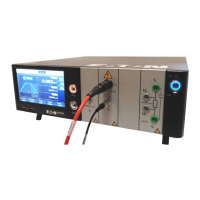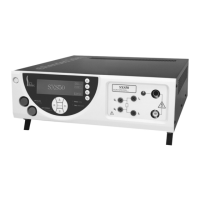User manual SEFELEC 5x Series 188 v1.06
INSULATION RESISTANCE MEASUREMENT
The insulation resistance measurement is intended to verify that the various components and
sub-assemblies of electrical equipment have an insulation resistance such as the leakage cur-
rents do not reached inadmissible values.
The principle is to apply a DC voltage, stable and specified (selected among the standard val-
ues) between defined points and after a prescribed time, to measure the current flowing in the
tested material. By using the Ohm’s law (resistance = voltage / current), the result is given by the
value of the insulation resistance. Then this value is compared to the minimum threshold speci-
fied by the standard used for the test.
19.4.1. PRECAUTIONS TO BE OBSERVED
It is important to connect the specimen to be measured in taking care of the parasite leak-
ages which could be created by the measurement operating procedure.
The supplied accessories have a shielding which is connected to a guard potential, this in-
sures a good immunity of the measurement regarding the parasitic leakage currents and
the AC residuals.
When using extending of the basic probes, take the necessary cares to avoid to introduce
measurement errors (short leads, leads not touching any metallic or insulating parts,...).
During insulation resistance measurements having high values (> 100 Gohms), the prox-
imity of the operator putting his hand close to the specimen under test, can alter or make
unstable the measurement. It is important to beware of Nylon blouses or of insulating ma-
terial things capable of generating by static electricity, high electrical fields which can alter
the measurement of high value resistances (100 Gohms under 100 VDC = 1 nA of meas-
urement current)
19.4.2. MEASUREMENT OF CAPACITORS
We remind that a lot of recent electrical units are fitted with main line filters including ca-
pacitors for the electromagnetic compatibility. When measuring on capacitors it is advised
to select the filter mode CAPACITOR of the SETUP menu in order to stabilize the meas-
ured values.
A) Indeed, on capacitors, the variations of the measurement power supply, even small as
well as the interferences are entirely transmitted to the input of the current measurement
system which have a very high gain, and therefore will amplify these variations. The CA-
PACITOR filter switches on circuits which will limit the instability of the measurement.
B) Never perform insulation resistance measurements on capacitive specimens in reduc-
ing the measurement voltage between each test, but always in increasing the voltage. The
hysteresis and polarization phenomena of the dielectric material will alter the results. In

